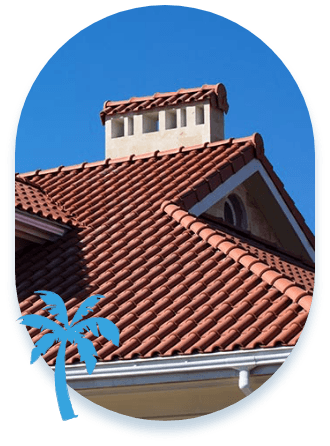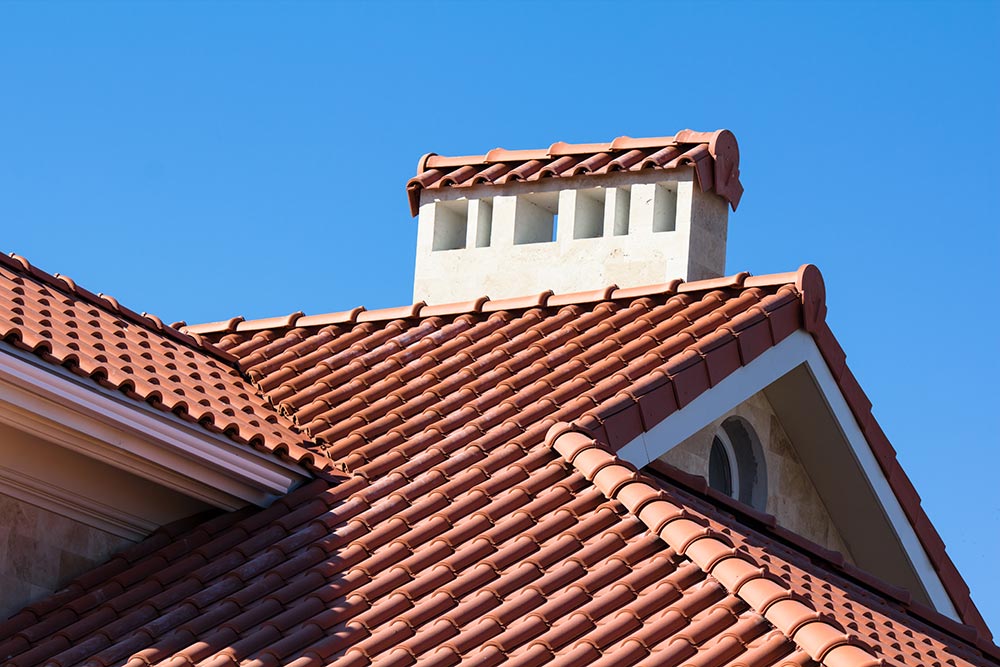 Because they’re so durable, it’s not unusual for clay tiles to last longer than the decks to which they’re installed. They’re made of molded clay that’s baked in a kiln at very high temperatures. They were once molded by hand, but modern technology has allowed them to be formed into a number of shapes, colors, and textures. The beauty and versatility of a clay tile roof can add extra character to any home, which is why it has been a popular option for such a long time.
Because they’re so durable, it’s not unusual for clay tiles to last longer than the decks to which they’re installed. They’re made of molded clay that’s baked in a kiln at very high temperatures. They were once molded by hand, but modern technology has allowed them to be formed into a number of shapes, colors, and textures. The beauty and versatility of a clay tile roof can add extra character to any home, which is why it has been a popular option for such a long time.
The Advantages of a Clay Tile Roof
A clay tile roof is virtually fireproof, and it requires very little maintenance. It also has a long lifespan, which is approximately 50 years. But some clay tiles can last up to a century. Archaeologists have even found Grecian roof tiles from the 3rd Millennium B. C. that we still in good condition. They cost more, but their natural beauty is worth the extra money.
They can add value to any property, and they work well in hot climates (such as the one we have in South Texas). They’ll never rot, and insects can’t get through them. You should, however, avoid walking on them because they can chip and break. Due to their weight, clay tiles may need more roof support (which can add to the cost of installation). But they can last longer than asphalt by several decades. In fact, a clay tile roof can last longer than two or more asphalt roof replacements.
Clay tiles can come in a number of different shapes and sizes, so they can fit any architectural style. Flat tiles can work well with homes that have a French or English style, while curved tiles can work with Spanish or Mission-style structures as well as homes that have an old-world European or Southwestern appearance. In fact, clay tiles are one of the most attractive and versatile roofing materials on the market today.
While it will require more money upfront, it can offer a number of benefits in terms of versatility, durability, and longevity. Aside from their great curb appeal and need for very little maintenance, they can make your home more energy-efficient. It’s also better rated for enduring fires and hurricane-force winds.
Your Choice for the Installation and Repair of a Clay Tile Roof in the Coastal Bend!
If you’re looking for the best choice for the installation and repair of a clay tile roof in the Coastal Bend, Bayfront Roofing and Construction is here to help. Our team can handle any type of roofing project, and we guarantee that you’ll be satisfied with the results. We’re roofers in Corpus Christi that have been able to service many different clients in the Coastal Bend, so we know that you’ll be happy with any type of roof installation or repair. That’s why we’re among the top choices for roofing companies in Corpus Christi, Texas.

Clay Tile FAQ
When it comes to installing a new roof, choosing the right materials is a big decision because it can affect everything from curb appeal to long-term structural integrity. Out of all the available options, clay roof tiles stand out because of their beauty, durability, and eco-friendliness. If you’re looking for an alternative roofing material that will give you a number of customization options and long-lasting durability, clay roofing tiles may be the right choice for you.
Here are some common questions people ask about clay tile roofing.
What are clay roof tiles?
Clay roof tiles are made from natural clay that’s molded, dried, and fired at a high temperature inside a kiln. This process gives them a great deal of strength and resilience, which allows them to withstand the elements for decades. The clay often consists of a blend of different types, so it will have specific properties with regard to color and workability. The firing process vitrifies the clay, which makes it hard and resistant to water.
What are the benefits of clay tile roofing?
Some of the benefits of clay tile roofs include the following:
- Durability — Clay tiles can last for 50-100 years (or even longer) with the proper maintenance, which makes them a solid long-term investment.
- Aesthetics — The natural variations in color and texture give them a classic and elegant look, so they can enhance the curb appeal of any property.
Because they’re made from natural materials, clay tiles can often be recycled and will have less environmental impact than some of the more synthetic options. Their thermal mass can also be helpful in terms of energy efficiency.
How does the lifespan of clay tiles compare to other roofing materials?
Clay tiles can last well over 100 years if they’re taken care of properly. They’re also used interchangeably with terracotta tiles, which have a similar lifespan. But the term “terracotta” refers to a type of unglazed earthware with a reddish-brown color.
Here are the lifespans of other common roofing materials:
- Concrete Tiles: 30-50 years.
- Asphalt Shingles: 15-30 years.
- Metal Roofing: 40-70 years.
- Slate Roofing: 75-150+ years.
Be sure to speak to a professional roofer for more information.
What are the different types of clay tile roofing?
The versatility of clay roof tiles allows you to choose from a variety of styles, colors, and finishes that can work with a number of architectural designs. Some of the common styles for clay tile roofing include the following:
- Barrel Tiles — These tiles are characterized by their semi-cylindrical shape, so they look like half-barrels. They’re laid in alternating convex and concave patterns, which creates a distinctive Mediterranean or Spanish-style roof.
- Flat Tiles — As the name suggests, these tiles are laid flat and can be installed in a variety of patterns. They can have a more traditional or contemporary look (depending on the layout).
- Spanish-Style Tiles — These often refer to barrel tiles, but they can also refer to S-shaped tiles that can create a similar undulating appearance.
A professional roofer will be able to advise on which option is right for you.
What are the different color and finishing options for clay tile roofs?
Some of the different colors and finishes for clay tile roofing include the following:
- Red — This is the most traditional color, which comes from the natural iron content in the clay. But the variations in firing can produce different shades of red and brown.
- Black — This color is achieved through a specific clay composition and firing process, which allows the tiles to have a bold and dramatic look.
- Green — This color is usually achieved through a glazing process as well. It’s also a great choice if you want your roof to have a more unique and contemporary look.
- Glazed — This will give the tiles a glossy finish that makes the color more vibrant. It also makes them more water-resistant and easier to clean.
- Unglazed — This will give the tiles a more natural, matte finish that will highlight the texture and color variations of the clay.
Be sure to speak to a roofing professional about all the different color and finishing options for clay tile roofing.
How can I keep my clay tile roof maintained?
Here are some things you can do to maintain your clay tile roof:
- Cleaning — Regularly remove moss, algae, and debris with a soft brush or low-pressure washer spray. Avoid high-pressure washing, because it can damage the tiles.
- Sealing — Clay tiles are naturally resistant to water, but some homeowners choose to apply a sealant to enhance their protection (especially if they’re in harsh climates). Just make sure the sealant is compatible with clay tiles.
- Inspection — You should perform a roof inspection at least once a year and after a severe weather event, because it will allow you to identify any potential issues before they get worse. Look for cracked or missing tiles, loose flashing, and debris buildup.